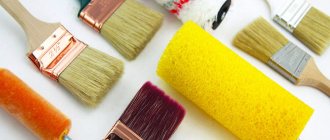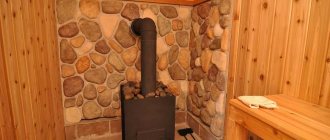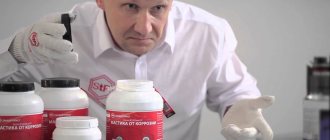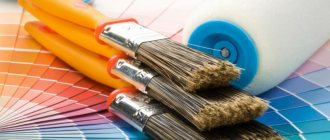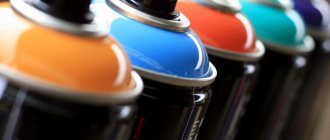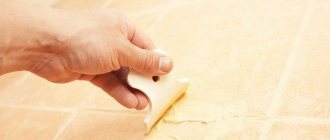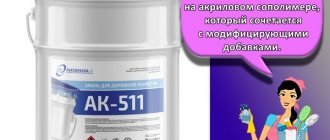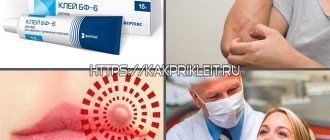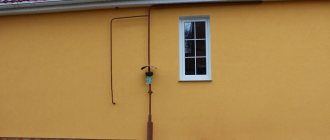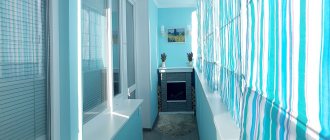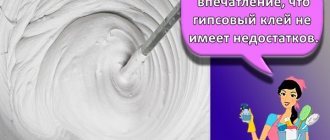Any person who has started renovating an apartment or house is faced with choosing a brush for painting. What is the best brush to use to paint a wall? What bristles are suitable for repair work? Which pen will be more convenient to apply paint with? The answers to all these questions will help you easily choose the right brush and quickly and efficiently complete the repair that has begun. After all, a high-quality brush will help you easily distribute the paint and varnish material on the wall, ceiling and any other surface, and be satisfied with the result of the work done.
Brushes: pony, synthetic, squirrel, kolinsky, goat, nylon
6 brushes, different bristles. Review of brushes with different bristles, as well as palettes for painting. Which brush is better: squirrel, goat, kolinsky, pony, bristles or synthetic?
Which brushes are ideal depends on the quality of the brushes, paints (watercolor, oil, gouache, etc.), and the habits of the painter.
Squirrel brushes are the softest and most flexible. Colonel is soft, but elastic, it is tougher than squirrel. Modern synthetics are close in quality to columnar. It does not wear out as quickly as natural bristle brushes, and is even more convenient to use because its bristles are smoother. Most artists prefer to work with natural brushes, but synthetic brushes are also great for children’s painting.
To paint with watercolors, use brushes: squirrel, kolinsky, synthetic.
Kolinok
is suitable for any style of painting, but it is also one of the most expensive. If you are in doubt about which brush to choose, you can use Kolinsky.
Squirrel
good for watercolors, synthetics - for acrylic painting. The tip of the squirrel hair brush is sharp and has the same fluidity control as a kolinsky brush, but is not as elastic as a kolinsky brush.
- Catalog of painting brushes - choose!
Pony
Usually they take it when it is not possible to take a weasel or a squirrel. Ponies are tougher than squirrels, they are closer to the column.
Pig bristle brush
Best suited for acrylic and oil, it allows you to work even with very thick paint.
Badger brush
good for soft paints, it is very easy to work with.
Sable
In terms of properties, it combines the kolinsky and the squirrel; number 2 can be used to paint both miniatures and large works.
Nylon bristles (synthetic)
Not suitable for watercolor, but great for acrylic.
The brush should not be very soft, but not too hard.
For working with gel polish
The dome of the brush can be made of either synthetic or natural hairs. The main thing is that the bundle is rigid and elastic, which will allow you to simulate the shape of the nail from a viscous and viscous gel and avoid unevenness when creating the shape.
Of course, it is much more convenient to use synthetics due to the smoothness of the fibers, on which the material does not linger. But everything is individual and depends on experience and skills.
How to choose the right gel polish: we analyze all its types and top brands
Squirrel brushes
The traditional, well-known brush is a squirrel brush, it is soft, thin and elastic, the strokes are juicy and bright. It usually consists of a wooden stylus and a galvanized braid that clamps the squirrel's hair.
Brushes with different bristles.
The squirrel brush holds its shape perfectly, does not break, absorbs moisture well and is easy to clean under running water. When in contact with paper and other surfaces (porcelain, earthenware, wood), the hairs do not separate and lead a clear line, without “stripes”.
The most valuable among artists are brushes made from the upper part of the tail of a Siberian squirrel. The best hair is in the tail
whites, the hairs are the longest there.
Squirrel fur has good moisture retention properties, which makes it different from kolinka hair when working with watercolors and tempera paints. When wet, a squirrel brush gathers into one dense bunch, which is suitable for painstaking contour work. It can be kept in water for a long time.
Storage rules
- Brushes should be stored strictly in an upright position, with the bristles facing up. In this case, the pile should dry. It is not recommended to place wet instruments vertically, otherwise they will fluff up.
- It is advisable to store brushes in a special case or case, which will protect them from fading and significantly extend their service life.
In the next article, we looked in detail at the technique of working with the 11 most common types of brushes, how to hold them correctly and apply the material to the nails, how to use them to make interesting designs and ornaments, and what you can use instead of brushes.
Comment
Column Brushes
The kolonok is an animal from the weasel family, its fur has excellent properties - it is soft and elastic. The bristles of the kolinsky brush adhere perfectly to water, improve the flow of paint, and are suitable for working with watercolors (including professional ones).
The core brush is the leader among brushes. The hair of kolinsky brushes is thin, elastic and has a conical shape. The paint flows from the tip of the brush in a continuous stream and with the best consistency. They are distinguished by a combination of elasticity and elasticity, while at the same time remaining soft.
From top to bottom, brushes in the photo: nylon 7, goat 7, synthetic 6, synthetic 5, kolinsky 4, squirrel 7.
Column brushes are designed for artistic work with watercolor, oil, tempera, gouache and acrylic.
. In oil painting they are used for small details. There are round and flat.
But who is this speaker? Few have heard of this animal.
The kolinok (lat. Mustela sibirica) is a valuable fur-bearing commercial animal, from the genus of weasels and trochees, its fur is highly valued, and long hairs from the tail are used for artists’ brushes. The fur of the kolinok is very thick, soft, warm, and lush.
Kolonok is a red animal, smaller in size than a cat, flexible, and has a black “mask” on its face. He hunts relatively large animals: hares, black grouse, wood grouse. It does not consume plant foods; in extreme cases, it can feed on insects. All winter he sits in a hole, moving, if necessary, under the snow. In the snow tunnels, the kolonok catches voles. He stores food for the winter and sets up entire warehouses.
Winsor & Newton Series 7 brushes (see brush catalogue) are the highest quality kolanka brushes available. The name of the series comes from 1866, when Her Majesty Queen Victoria ordered W&N to produce brushes for her of the best quality, her favorite size No. 7. As a result, Winsor&Newton named a whole series of brushes “Series7” in honor of this memorable event. These brushes are handmade
.
They will give you a unique pleasure from working with watercolors, because they are made by professionals from the best materials and according to the best traditions, by hand. True, their price is... very high, royally
Brushes “Series 7” from Winsor&Newton, columns.
Pony brushes
Unlike ordinary horses, which have hard hair, pony hair (from the mane and tail) is soft, so it is used to make tassels. Scottish pony hair is especially valued for brushes. The pony brush hair is of medium hardness, closer to soft.
The hairs of a pony's brushes are somewhat thicker than those of a squirrel, the distance between the hairs is greater, so such a brush takes up less water than a squirrel or column brush. Gathers into a cone shape, not too elastic.
Ideal for beginning artists and often used in children's educational institutions.
Advantages: reliability, durability (strong, thick hair).
Used mainly for paints: watercolor, gouache, tempera, as well as glue and cosmetic purposes
Often used by preschool and primary school children.
Pony brushes absorb paint well, but they don’t give off paint as readily as they absorb it.
What is the minimum set for professional makeup?
The “basic” set of face makeup brushes includes: one flat product and two fluffy tools. The choice of pile between natural and artificial is up to the buyer. A flat brush is used to apply foundation, and two fluffy brushes are used for powder and blush.
Lovers of bronzers and other similar dry products will find a Kabuki brush useful. It is distinguished by thick pile, softness and the presence of a rounded cut. With this tool, makeup will look as natural as possible.
In addition to this, for a full make-up you will need:
- brush for lipstick, eye shadow,
- applying eyeliner, if used,
- shading tool,
- brush for makeup and visual eyebrow correction.
That is, you will have to acquire at least eight tools.
Bristle brushes
Bristle brushes are made from selected pig ear hair. Bristle brushes are used for professional watercolor painting on paper with a rough texture, on canvas.
Bristle brushes are especially convenient for drawing contours and creating contrasts; the hairs should not bristle.
The best bristle brushes are made from the hair of the Chinese Angking hog. The elastic, strong bristles of this animal (hair reaches 20 cm) are subjected to special processing - the bristles are boiled and bleached, and only the white hair is used to make professional brushes.
In addition to elasticity, bristle brushes have another important feature: the split tip of the pig's hair contributes to good fullness of the brush and its even application to the surface. They wear out over time, but are easy to replace because... they are inexpensive.
There are both flat and round, used for working with oil, acrylic paints, and gouache using dry techniques.
For painting
Start assembling your kit with three basic tools: a point brush, a flat brush, and a round brush. With their help, you can do all the basic processes for creating decorative nail art.
Of course, for drawing it is better to use brushes with natural hairs, but first use synthetic ones. Paints and varnishes do not flow on it and are not absorbed. Practice the technique, then switch to professional tools made from natural bristles, which are more durable in use.
Details about painting on nails, what else you will need from tools and materials, as well as step-by-step instructions and examples of work.
Synthetic brushes
Synthetic brushes are an analogue of natural brush in terms of rigidity and elasticity, and in price - an order of magnitude cheaper. The elasticity of the hair is even higher than that of kolinsky, however, synthetics are inferior to kolinsky in terms of filling the brush with water and the volume of absorbed paint.
High quality painting brushes.
With synthetic brushes you can draw clear and even lines.
Synthetic brushes are made from nylon, polyester and other fibers
The standard thickness of brush hair is 0.08 mm, but there are other options: with thick hair, the elasticity of synthetic hair is close to bristles, but the shape and water-repellent properties are retained, and with thin hair, a synthetic brush absorbs more water and it becomes softer, close to kolinsky hair .
The quality of synthetic brushes made in Japan is highly valued; they produce fiber using the drawing method; the brush hair is not cut, but pulled at a certain angle. Such brushes are often called artificial kolin, they are resistant to acids and caustic liquids, so they can be used for glue, and they are not afraid of thinners.
Synthetic hair based on nylon
- it is hard and does not release water, it is not suitable for watercolor painting, but
it is excellent for oil paints and acrylic
Synthetic hair based on polyester fibers
has a capillary effect, which allows the use of such brushes even in
watercolors.
In terms of resistance to mechanical stress, synthetic brushes are inferior to natural ones, because the fibers quickly wear out and become soft. But such brushes are inexpensive, professional artists buy synthetics in large quantities, and these brushes are very suitable for children’s painting.
Application area
The paint brush is most widely used for household work. In particular, it is most often used for such work:
- applying wallpaper glue;
- painting walls, doors or floors;
- painting window frames and other structural elements;
- painting garden benches;
- updating worn-out furniture of different sizes.
The latter use of brushes is becoming increasingly popular. When used correctly, a paint brush will allow you to restore furniture or, conversely, make it look older or more sophisticated. For example, you can paint on the surface in the form of trees, marble or other designs.
Modern professional brushes have a fairly simple design. The main part of the product is the handle, onto which the working surface, which looks like a long tuft of pile, is attached using a bandage.
To apply the paint material correctly, you need to soak the brush in the paint and transfer it to the surface. In this case, for uniform distribution there must be pressure on the brush. The effectiveness of painting depends on the appearance of the work surface.
The final result will depend on the correct application of paint with a brush.
Preparatory stage
Once you have purchased a paint brush, it is not recommended to start painting right away. If you do not prepare the tool, then due to too stiff bristles, streaks may remain on the areas being painted. To avoid this, you should immerse the brush in a water-based solution for about one hour. All this will lead to the fact that the bristles of the tool will become larger and softer, making it easier to apply the composition to the surface.
If you want to apply oil paint, then you need to keep the brush dry. However, even then, there may be streaks left by the protruding stubble hairs. To completely eliminate them, you should first work with the tool on a hard brick or plaster surface. Before this, the round brush is moistened with paint and varnish composition or water. This will smooth out any raised bristles and allow the paint to apply more evenly.
Brush care rules
A brush, like other tools, can gradually wear out. Therefore, in order to increase their service life and maintain the quality of paint application, you should follow some care rules. For example, during painting work, the enamel brush needs to be rotated so that it wears evenly. It is also recommended not to apply too much pressure, so as not to lead to increased wear of the product.
To increase the service life, you should follow the rules of brush care.
After each stage of work, the round synthetic brush should be suspended above a container of water, without touching the bottom. This is necessary so that the pile does not bend and become unusable. The brush can also be suspended in the container with the paint you are using. If you work with wooden tools, it is better not to dip them in a water-based liquid to prevent hair loss.
After completing the painting work, it is recommended to rinse the painting tool in kerosene to completely remove paint residues. After this, the brush is washed in soapy water until the water stops being colored. Next, the instrument should be hung for further drying and stored in this condition.
What does the number on a paint brush mean?
The number means the width, diameter of the brush in mm. This is the size of the brush - from thin “zero” to thick brushes 10, 12... Round brushes are collected in a round clip and, depending on the diameter of the clip, the size is numbered, starting from 0 to 20 and above, in increments of 1 mm. Round brushes can be either regular or with long bristles (one and a half times longer than the standard).
Palette.
Artistic brushes for painting come in round, flat and fan shapes.
Zero brushes are the thinnest, they are assembled from literally several hairs, and are used for drawing small details, for miniatures.
Zeros are usually made from kolonka; squirrel zeros are almost unsuitable for work, they are too soft.
There are brushes numbered 00 (two zeros), but such brushes are difficult to work with because the paint does not stick to one hair. At the same time, if the brush is of high quality and correctly assembled, then with number 2 it is quite possible to paint miniatures.
The difference between brush numbers 0 and 1 is insignificant, and given that the brush tends to wear out, it is better (especially for a child) to choose brush 1, and then it will turn into number 0.
It is better to use a squirrel brush starting with size 2 and above, optimally 3-4, for watercolors 4-6.
A flat brush is a regular round brush, only flattened. Sizes for flat brushes are numbered only in even numbers.
– the smallest size is 2, then 4, 6, 8, 10, 12, large ones 16, 18. The fact is that when you squeeze a round brush with number 1, it turns into a flat 2 mm. When a round two is compressed, a flat 4 is obtained. But when flattening, it is not always possible to make strictly 4 mm from No. 2; it may turn out to be 3 or 3.5 mm. To avoid having too many sizes of brushes (there is no point in this), flat brushes were graduated by even numbers; all inaccurate ones are assigned to the nearest size.
Flat brushes include a flute - this is a wide flat brush, number 20 (width 2 cm). They are used for large works - for example, when painting iconostasis, in wall paintings.
Dimensions and weight
Tool parameters are determined by purpose.
The width - or diameter, if the brush is round, for paint brushes varies from 6 to 200 mm, the length of the pile - from 12 to 180 mm.
The weight of the products does not exceed 500 g.
Artistic brushes are noticeably smaller.
They are classified according to the diameter of the crimp base, and are marked as follows: No. 1 - 1 mm thick, No. 2 - 2 m thick, No. 12 - 12 mm.
In fact, there is no general classification, since there is no correspondence between the sizes of the base from different manufacturers, so the division described is somewhat arbitrary.
Makeup brushes have a minimum weight – from 7 to 20 g.
The operating parameter is the volume of the crimp base; it ranges from 1.5 to 15 mm.
The length of the hair is also indicated - 7, 10, 12 mm.
